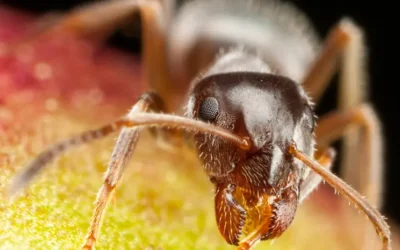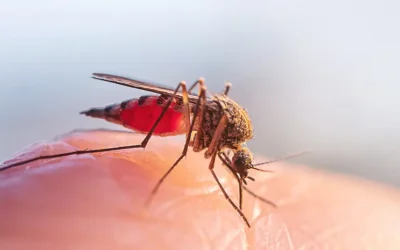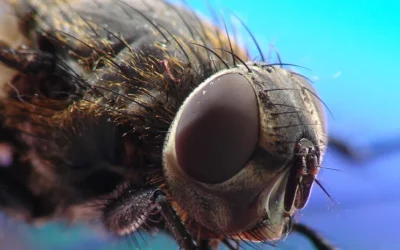On a warm afternoon, when you finally have a moment to sit on the terrace or balcony with a glass of lemonade, something suddenly appears—buzzing, circling, and refusing to leave you in peace. Instinctively, you think: “wasp.” But is it really? Many insects resemble wasps, yet not all of them are as bothersome.
Some, in fact, only pretend to be dangerous to scare off predators. That’s why we want to introduce you to the fascinating world of wasp-like insects and show you how to tell them apart. You’ll also learn how to safely and effectively reduce their presence around your home.
Why do insects mimic wasps?
The natural world is full of examples of camouflage and pretending to be stronger than you are. Wasps are feared by many predators – so looking like a wasp can be an effective defense mechanism.
But for us humans, mimicry means one thing: it’s easy to get confused. That’s why it’s worth knowing who’s who in the striped team:

1. Common wasp – the striped aggressor
This is the most common uninvited guest at a barbecue. The common wasp (Vespula vulgaris) builds nests from paper-mache like material, often in the ground, attics, or garden sheds. Wasps are curious and attracted to food: meat, fruits, and sweet drinks.
Does a wasp sting without reason? Usually not, but it can become aggressive if it feels threatened or if you get too close to its nest. Even its mere presence buzzing around can quickly ruin the enjoyment of being outdoors. A wasp can sting multiple times, which makes it far more dangerous than a bee.
Czy osa żądli bez powodu? Raczej nie, ale może stać się agresywna, gdy poczuje zagrożenie albo gdy zbliżysz się do jej gniazda. Zresztą już samo jej latanie w naszym pobliżu może skutecznie odebrać przyjemność z przebywania na zewnątrz. Osa może żądlić wielokrotnie, co czyni ją dużo groźniejszą od pszczoły.

2. European hornet – the demonized giant
Hornets (Vespa crabro) look like wasps on steroids – and… they are wasps, just much bigger. Contrary to popular belief, hornets are not more aggressive than common wasps. They use their stinger only as a last resort. The problem arises when they build a nest near human activity.
Their stinger is larger, which means the reaction can be stronger in sensitive individuals. The best way to reduce risk is to monitor their presence and properly secure the area.

3. Honeybee – the calm workaholic
Although also striped, the honeybee (Apis mellifera) is a completely different story. It is hairy, calmer, and far less interested in your plate. Bees sting only when they must defend themselves, as stinging usually means death for them. That’s why it’s best to leave them alone—they are valuable pollinators.
How to tell a bee from a wasp? Bees are fuzzier, duller, and less contrasting in color. They’re also not interested in your orange juice.

4. European beewolf wasp – a solitary insect that looks dangerous
The beewolf (Philanthus triangulum) is a solitary wasp, often mistaken for typical social wasps. It features yellow-and-black coloring and a similar silhouette, but it lives alone and does not build large nests. It is known as the “bee-eater” because it feeds on honeybees – paralyzing them and carrying them to its burrow as food for its larvae. It generally avoids contact with humans and rarely stings. Its appearance is a classic example of protective mimicry – it looks threatening, but in reality, it is a peaceful solitary wasp.

5. Flies That Mimic Wasps – Masters of Camouflage
Here is almost like an insect theater. Some flies (e.g., hoverflies) have yellow-and-black coloring, move in jerky motions, and can hover motionless in the air – just like wasps. This is an example of Batesian mimicry, a strategy in which a harmless insect imitates a more dangerous one to gain protection.
They are completely harmless, but to an unsuspecting observer, they can look frightening.
How to behave when encountering wasp-like insects?
Above all: stay calm. Most of them are not interested in attacking unless they feel threatened. Avoid sudden movements, don’t wave your hands, and don’t approach their nests.
But if wasps, hornets, or flies start showing up too often on your terrace or in your kitchen, it’s worth taking action.
How to get rid of wasps and flies from your home and garden? A solution that outsmarts the insect’s instincts.
One of the most effective and safe methods is using the WASP & FLY TRAP. It’s a ready-to-use, stylish, and highly effective solution.
- attracts wasps, flies, and hornets,
- works without the use of toxic substances,
- can be used in gardens, on balconies, and terraces,
- reduces insect populations without harming bees.
A trap for wasps, flies, and hornets – effective, safe, and ready to use.
👉 Order at: https://sklep.icbpharma.pl/produkt/pulapka-na-osy-muchy-i-szerszenie/
Keep your eyes open and use traps that work effectively and selectively – without harming beneficial insects.



